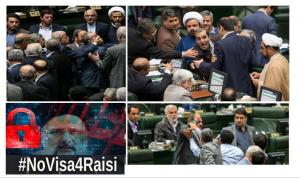(Video) Khamenei’s hold on power weakens as inner conflicts grow in Iran’s regime

Faced with increasing global tensions and an explosive society, Ali Khamenei resorted to a series of political measures to consolidate power and stabilize his regime. The campaign was the appointment of Ebrahim Raisi, a key figure in the 1988 massacre.

Disputes between the executive, judiciary, and legislative branches, as well as the Revolutionary Guards (IRGC), the key pillar of Khamenei’s power, have reached a point that the regime’s own officials are raising alarms about where such quarrels can lead to.

As the controversy surrounding Mobarakeh Steel continued to mount, Mohammad Bagher Ghalibaf, the Speaker of the Majlis tweeted, “This report should not have been made public.”Majlis officials, who were appointed to support Raisi, are now criticizing his gov.
It is only a matter of time before another nationwide uprising happens. And when it does, Khamenei will not have the unified regime he needs to stop it.
The epitome of this campaign was the appointment of Ebrahim Raisi, a key figure in the 1988 massacre of more than 30,000 political prisoners, as the regime’s president. Khamenei also purged the Majlis (parliament) of his rivals, hoping to form a united front against domestic unrest and international pressure.
However, little over a year into Raisi’s presidency, the regime is faced with growing infighting as officials who were supposedly allies are now at each other’s throats, incriminating each other for the numerous crises that the regime is facing in the socio-economic and political arenas.
Disputes between the executive, judiciary, and legislative branches, as well as the Revolutionary Guards (IRGC), the key pillar of Khamenei’s power, have reached a point that the regime’s own officials are raising alarms about the directions that such quarrels can lead to.
One key dispute that hasn’t diminished is the struggle for economic power. An example is a recent Majlis investigation into a 920-trillion-rial embezzlement case of Isfahan Mobarakeh Steel company, which was supposed to expose corruption in the government of Hassan Rouhani (Raisi’s predecessor), but ended up revealing much deeper corruption across dozens of regime institutions, including the IRGC, Friday Prayers leaders’ offices, other state-owned companies, and the Majlis itself.
Following the Majlis report, MP Hossein Mirzai, who was involved in the investigation, revealed in a TV interview that some officials were offering monetary bribes to modify the contents of the report.
As the controversy surrounding Mobarakeh Steel continued to mount, Mohammad Bagher Ghalibaf, the Speaker of the Majlis tweeted, “This report should not have been made public.”
While regime officials continue to fight over who gets to loot a bigger share of Iran’s wealth, they are also afraid of the simmering public anger aimed at regime leaders and officials, who have become to symbolize the source of all the people’s suffering.
Majlis officials, who were appointed to support Raisi, are now constantly criticizing his government’s abysmal performance and how the continuously declining economy is exacerbating public dissent.
The tension between the Majlis and the Raisi government has quickly reached the point that several MPs have called for key government officials to resign.
The latest example is Javad Karimi Ghodoosi, an MP with close ties to Khamenei, who called for the resignation of Raisi’s first VP, Mohammad Mokhber. “Every hour he stays causes damage,” Ghodoosi said.
Inner conflicts have spread to other areas, including the nuclear talks. While there are talks of a potential agreement, Keyhan Daily, the newspaper that reflects the views of Khamenei, published a piece on August 22, tacitly attacking the Raisi government and saying, “The claims made about the nuclear deal are all lies. No sanctions will be lifted in this agreement.”
Again, it is important to see this sign of these disputes in light of the immense efforts that Khamenei and his entourage have undertaken to make sure that the power hierarchy is as unified and aligned as possible.
These and many other disputes at the highest level of power are proof of the failure of Khamenei’s “Raisi project.” Khamenei has not managed to reach his ultimate goal, which is to suppress the opposition and to the expansion of protest movements.
Protests have grown more intense and frequent during Raisi’s tenure, and “Death to Raisi” has become a popular slogan across Iran. People are suffering from hunger & poverty.
It is only a matter of time before another nationwide uprising happens. And when it does, Khamenei will not have the unified regime he needs to stop it.
Shahin Gobadi
NCRI
+33 6 61 65 32 31
email us here
The fatwa is one of the sharpest signs of the Iranian regime’s sponsorship of terrorism, and the regime is not shy away from the terrorist acts in its media.
Legal Disclaimer:
EIN Presswire provides this news content "as is" without warranty of any kind. We do not accept any responsibility or liability for the accuracy, content, images, videos, licenses, completeness, legality, or reliability of the information contained in this article. If you have any complaints or copyright issues related to this article, kindly contact the author above.


